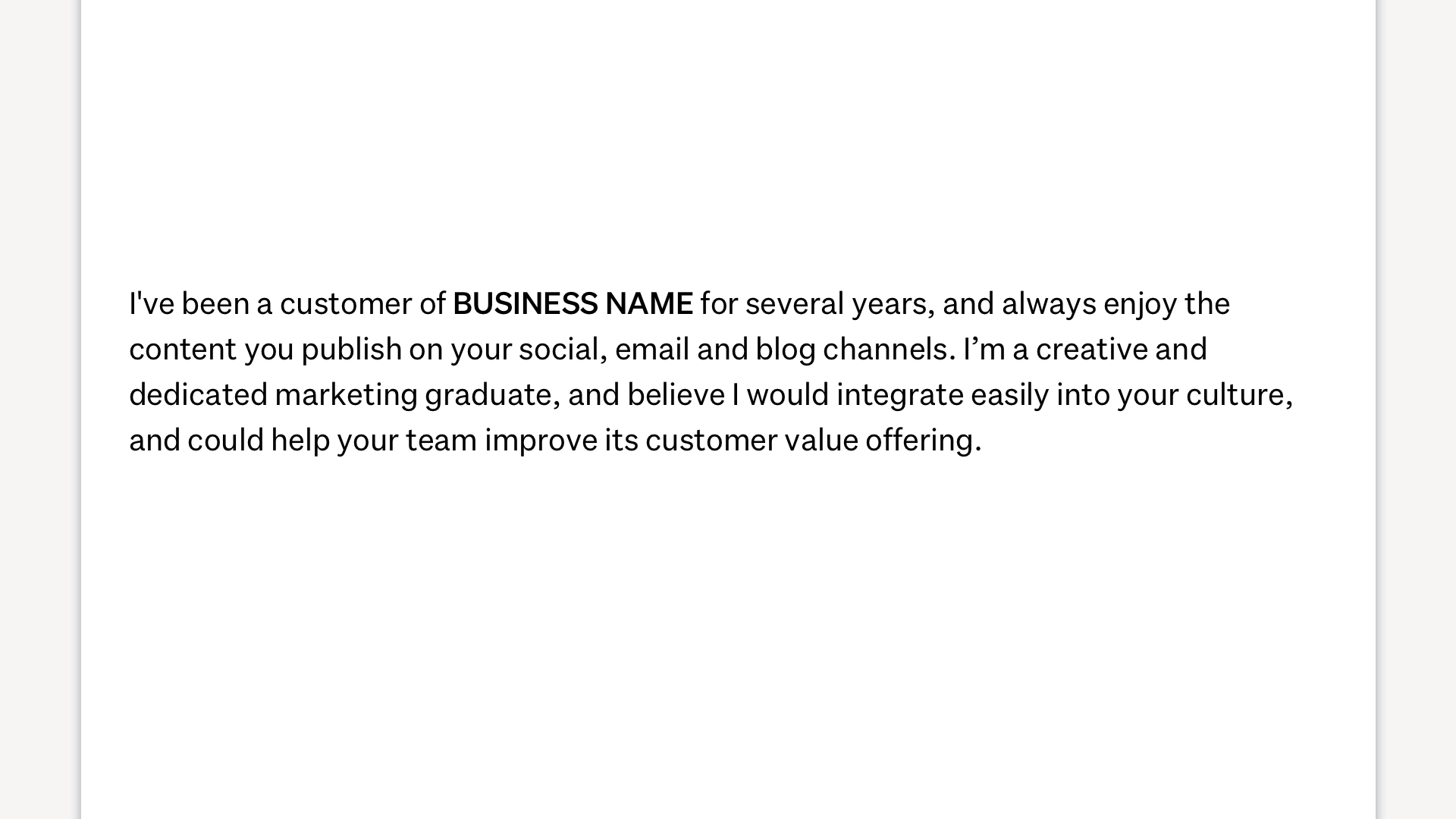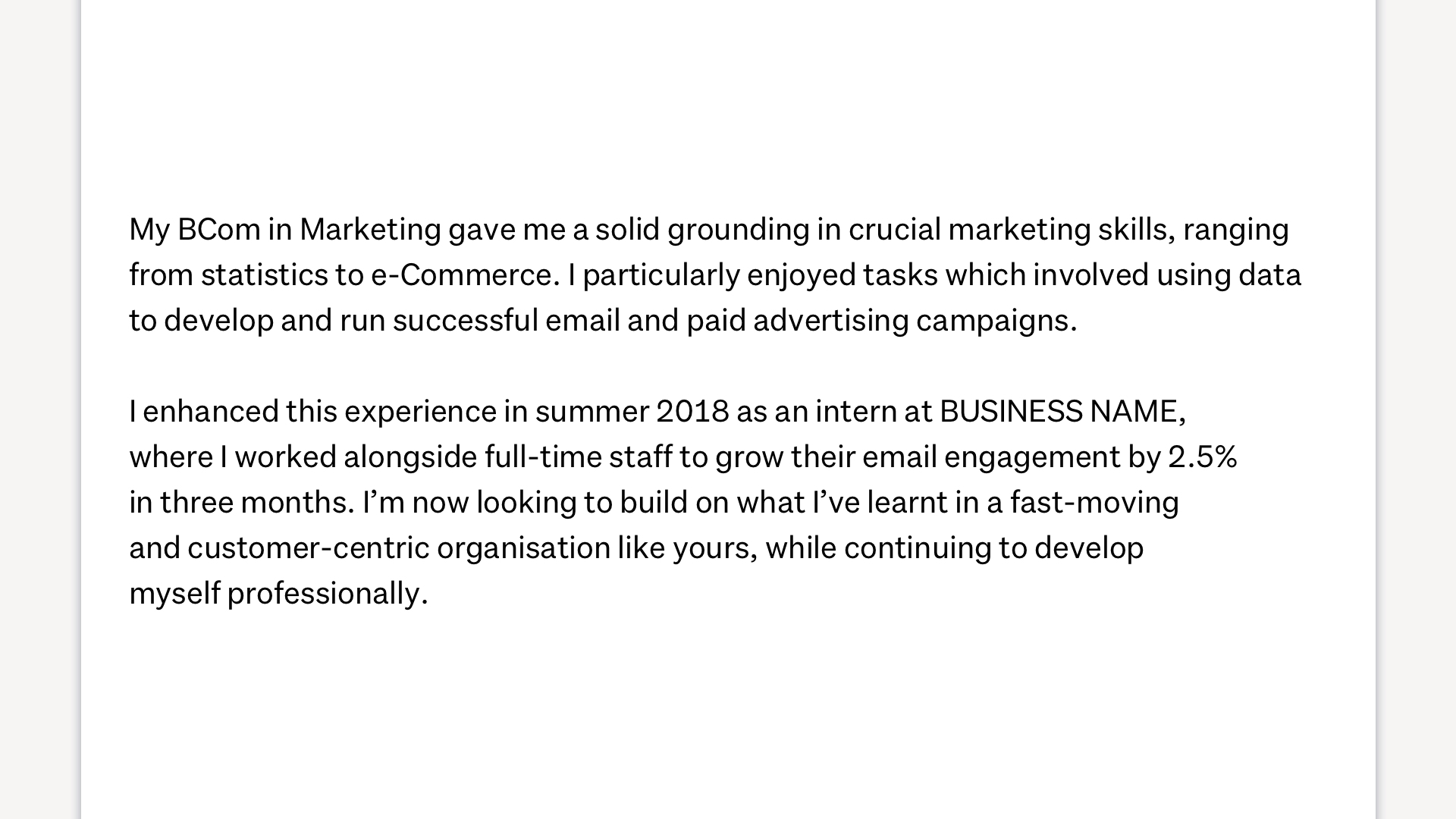Careers advice
How to tailor your cover letter (with examples)
Sending the same cover letter in different applications might seem quick and easy, but is it damaging your chances?
What you’ll learn:
- Can you use the same cover letter for more than one job?
- Examples of how to tailor your cover letter for each job application.
- How to research a company, and how to use this information in your cover letter.
- The role of keywords in your application.
When you’re deep into the job search, you’ll be tempted to take any steps possible to make your hunt more efficient.
However, while we’re all about working smart over working hard, sometimes trying to speed things up too much can damage your job application. Today, we’re going to look at this idea in relation to cover letters.
We’ll look at some key cover letter tips for job seekers, and explore some ways you can tailor yours in your next application. By the end, you’ll be able to create a cover letter that speaks directly to whichever organisation you're applying for, highlights your key skills and experience, and even impresses robots.
Can I use the same cover letter for multiple jobs?
In a nutshell, no. In fact, doing this is one of the most common and costly cover letter mistakes applicants make.
But why is it so bad?
Think about the purpose of a cover letter. This part of your application is supposed to:
- Introduce you to the company or organisation.
- Show you’re interested in them, and the specific role on offer.
- Highlight your most relevant skills.
- Motivate the reader to call you in for an interview.
Looking at that list, it’s easy to see why sending the same cover letter for each job application is unlikely to get the result you want. This is because, depending on the unique requirements of the role and the organisation, things like your most relevant skills and why you’re interested in the role will be different in each case. Even in a scenario where you think you’re a perfect match for the role and have lots of relevant experience, you’ll still want to be creating the best possible impression by cherry picking the items from your CV that will be the most eye-catching. If you chose to send a generic cover letter to each employer instead, they might think you’re an okay fit, but the lack of specifics could give another candidate the edge.
What’s more, employers and recruiters can pick out stock cover letters easily. After all, they look at hundreds, if not thousands, of cover letters throughout their career, and, if they think you haven’t bothered to take the time to tailor your application, they’ll hear alarm bells regarding your commitment to the role and the company.
You want your cover letter to stand out from the crowd.
How to tailor an NZ cover letter (with examples)
There are a few important pieces of personalisation you should include in a cover letter to help you stand out:
1. The employer’s/recruiter’s name: this goes a long way, especially when compared with the awful ‘to whom it may concern’ (ew). If there isn’t a name on the job listing, have a stalk of the company website. If you’re still unsure, address it to the head of department, or go with 'Dear Hiring Manager'.
2. Why the role and business appeal to you: How does this role align with you and your professional goals? What made it stand out among all the other listings? You also need to explore the business, its goals, mission and history. A lot of this info can be found on company websites. Check out the section on researching the company below for more tips o how to do thisShowing you've studied the business is a great to way to demonstrate that this is a tailored cover letter.
3. Why you’re who they’re looking for: study the job description, and match your skills to what they’re looking for. Top tip: use your Trade Me Jobs Profile to skim your work experience and qualifications, and cherry pick the most relevant. Using facts and figures to highlight how you can benefit the company will take this part of your cover letter to the next level. We’ll cover this bit in more detail below in the section on choosing your keywords
Next, namedrop key skills from the job listing to show what you'd bring to their organisation.
4. Your sign off: use your closing paragraph to hammer home your unique combination of skills and experience, and politely prompt them to get in touch. Remember to finish up with “Yours sincerely,” and your name.
How to research the company for your cover letter
An important part of the message you’re trying to get across is that you want to work for the company because of who they are and what they do. This will also be important when it comes to your job interview, as it’s very common to receive a question along the lines of “why do you want to work for this company?”.
All of this means you’ll need to include thorough company research on your to-do list when it comes to writing a cover letter. There are two important, and complimentary, things you’ll need to do to research the company properly:
1. Google the organisation
The 21st century answer to any problem – Google it. This is important because the results you’ll see (except the company’s own website) can help you to form a relatively unbiased picture of the company. Has it been in the news recently? What for? For good or bad reasons? Are their reviews from former employers that paint a different picture to the one you have in your head?
In extreme examples, what you find might cause you to think twice about applying in the first place. But, much more likely, you’ll be able to understand what the organisation has been up to recently, and any cool or exciting projects it has coming up. This will all help you to demonstrate that you’re applying because you’re actually interested in what the company does, rather than because you need a job (even if the latter is more accurate!).
2. Check out the company’s website
Of course, you’ll also be able to find out what the company is doing by checking out its website. However, the main point of this second exercise is to understand how the organisation views itself, and how it wants to be seen. While you don’t want to gush or bootlick in your cover letter, there’s no harm in describing the reasons why you’d like to work for the company using the vision they have of themselves, as long as you’re not too obvious.
In particular, we’d advise you to spend some time checking out the company’s culture and values. It’s pretty common for these to be clearly signposted on company websites (here are ours, for example). Organisations place a lot of importance on their culture and values, so pick one or two items that really stand out to you and get them into your cover letter.3. Tap your network
If you know someone who’s currently working for the organisation you’re applying to, these people can be an invaluable resource, for a number of reasons. Firstly, organisations are often keen to take recommendations from existing staff, as this can cut down the time, and therefore costs, involved in hiring. This friend could be your ticket to the front of the interview queue.
What’s more, this person has already successfully done what you’re hoping to achieve – being hired by this organisation. So, it really would make quite a lot of sense to pick their brains on everything you can expect to face, and how best to tick the boxes. If they were applying to a similar role that you are, and you feel comfortable doing so, you could even ask to take a sneaky peak at their cover letter, to see if there’s anything they’re doing differently to stand out.
How to use keywords in your cover letter
So far, we’ve talked about how to tailor your cover letter to impress the humans reading it. But what about the robots? Don’t worry, you haven’t slept through some sort of futuristic armageddon in which robots are now our lords and masters. However, the use of automated applicant tracking systems (ATSs) are now commonly used by organisations when they are hiring candidates.
What are ATSs?
ATSs are software programs that collate and sort the resumes a company receives when it advertises a job online. Among the tasks they perform is ranking the applications from candidates, based on how well the applicants match the job profile created by the organisation.
A huge part of this is the presence or absence of keywords or phrases in a candidate’s CV and cover letter. For example, if an organisation is hunting for a software developer, the first step in the process might be for the ATS to scan the cover letters to ensure they include this term, i.e. “Dear NAME, I’m writing to apply for the software developer role you currently have advertised.” Potentially, any cover letters that don’t include this term could be discounted at this stage.
Of course, there will be other keywords and keyphrases the ATS will scan for, in particular around the key skills and experience the organisation is looking for.
How to tailor your cover letter to impress ATSs
We understand the idea of having to impress ATSs as well as hiring managers seems daunting, but, in reality, this is actually very easy. Here are the steps we’d recommend:
- Analysing the job description: Go through the job description with a fine tooth comb. In fact, we’d recommend copying and pasting the wording of the job description from the Trade Me Jobs listing into a Word or Google doc, and going through with a highlighter to really hone in on the most important bits. Here, you’re looking for the specific skills they’re seeking and experiences they’ll value. For example, “experience working in a Big Four company.”
- Include these terms in your cover letter: once you’ve identified your key terms and phrases, you need to factor these into your cover letter. Importantly, the keyword or phrase should be exactly as it appears in the job description, as this will be how it’s included in the ATS. However, you don’t want to parrot entire sentences or paragraphs back to the employer. Even if this gets past the ATS, there’s a good chance that the person who wrote the job advertisement will be the same person reading your cover letter, and will recognise their own words.
- Use a combo of long-form terms and their acronyms (where relevant): for example, if you were applying for a SEO manager position, you’d want to ensure your cover letter features both the acronym ‘SEO’, and ‘search engine optimisation’, to cover both bases.
- Keep your section headings traditional: it might be tempting to try and stand out by using non-standard section headings in your cover letter, like “What I’ve learnt”, rather than “Education”. We’d recommend avoiding this approach, as ATS are generally set up to recognise standard cover letter layouts.
- Think about your formatting: while ATSs can be very handy for employers, they obviously lack the intuition of a human reader, and a few things can confuse them, including:
- Columns and tables: ATS struggle to read these properly, meaning they might struggle to comprehend the information contained within them.
- Header and footers: the same issue applies, so don’t include things like the job title in these sections.
- Fonts: keep these simple - this isn’t the time for Geraldine.
- File type: save and submit your cover letter as a .docx wherever possible.
Tailored cover letter example
Please feel free to download the cover letter sample below and use it in your own applications!
Kev Jobs
1 Jobs Road
Jobsville
Wellington
Dear NAME,
I’m hugely excited about the Digital Content Specialist role currently advertised on Trade Me Jobs. I’m a skilled content strategist and producer with agency and in-house experience, and I’d love to be involved in your mission helping New Zealanders tickle more puppies.
My MA in COURSE NAME was all about creating and distributing high quality digital content, and I’ve applied what I learnt in various roles. As such, I understand the crucial role that high quality, efficiently targeted, content has in reaching your audience.
As a puppy owner myself, and someone who understands the health benefits of owning an animal, your mission is one that speaks to me personally, and I believe my firsthand experience will help me to craft content that will speak to users along various stages of their consumer journey. In addition, your company’s emphasis on creating an inclusive and collaborative working environment is something that’s very important to me, and I’m keen to learn and grow based on the interactions I’d have with other staff members.
At PREVIOUS EMPLOYER, I’ve spearheaded the company’s move towards SEO driven, user-focussed content. My primary responsibilities have included creating and implementing detailed B2C and B2B content strategies, drawing up content calendars, and leading email marketing campaigns. Tracking these results in Google Analytics and PowerBI, my content has increased our average monthly returning users by 48%, reduced our bounce rate and more than doubled our average pages per session.
I was also integrally involved in PREVIOUS EMPLOYER’S shift to a new CMS, and worked closely with designers and developers on creating a search optimised and user-friendly site experience. I continue to work with these teams, and other areas of the business, to ensure best practices regarding search engine optimisation and content production.
These experiences built on my time at OTHER PREVIOUS EMPLOYER, a content marketing agency. Here, I produced blog articles, social posts and eDM content for clients ranging from Heads And Shoulders to Knees And Toes. In addition to honing my SEO writing, researching and editing skills, I took on managerial responsibilities such as auditing junior writers and creating editorial briefs as well as tone and style guides.
As Communications Officer supporting the valuable work of YET ANOTHER PREVIOUS EMPLOYER, I devised and implemented a targeted social media strategy while also redesigning their website with updated, SEO-driven content. Communications guidelines I produced ensured that both internal and external communications conformed to the organisation's values while my press releases promoted their objectives to stakeholders and the public.
I believe I have the skills and experience to hit the ground running in this role, and would be thrilled to join an energetic team where I could both learn and enthusiastically. Thank you for considering this application and I look forward to hearing from you.
Yours faithfully,
Kev Jobs.
Other articles you might like




